Spatiotemporal Big Data for PM2.5 Exposure and Health Risk Assessment during COVID-19
Abstract
1. Introduction
2. Materials and Methods
2.1. Study Area and Datasets
- (1)
- PM2.5 concentration was obtained from the National Real-time Urban Air Quality Release System of the China environmental monitoring general station [24] (national air quality monitoring stations were in only 190 cities in 2014, and since then all cities have been covered). Data from 1670 stations were acquired until 2020. To present the spatiotemporal distribution of PM2.5, a GIS-based spatial interpolation is applied to convert to 1 × 1 km grid.
- (2)
- POI data, were derived from the National Bureau of Statistics [25] and the local bureau of statistics, mainly including six factors that affect the distribution of PM2.5 concentration, including urban GDP, green space, road area, the number of urban taxis, the number of urban buses, and the number of urban factories. Urban GDP includes primary, secondary, and tertiary industry GDP, in units of 10,000 yuan. The urban green area contains public, residential, unit affiliated, protective, production, road green, and scenic forest areas, and the unit is hectares. The road area includes urban main roads, secondary, and branch roads, with a unit of 10,000 m2. The number of urban taxis and buses is the total number of vehicles in operation at the end of each year. The number of urban factories contains capital-intensive industrial, labor-intensive, resource-intensive, and knowledge-technology-intensive factories. The time period of all POI data was from 2014 to 2017.
- (3)
- LBS data came from Tencent location big data [26], which use positioning technology to obtain a position in the whole scene. Relying on the full coverage and high accuracy of LBS data, to study the impact of the COVID-19 epidemic on population mobility, this study selected four main time nodes because of the limited permission to access the Tencent’s services, i.e., 25 December 2020, 11 January 2020, 7 March 2020, and 3 April 2020. On 25 December 2019 people in China were producing and living normally. The turning point of the COVID-19 outbreak was 11 January 2020. Since this period, the number of patients infected with COVID-19 has continued to increase. It is also the time node when the Spring Festival travel season began. The peak number of COVID-19 infections was on 7 March 2020. On 3 April 2020 the COVID-19 epidemic in China was basically under control, and the life of the people returned to normal. The temporal resolution of LBS data is the hour, and the data accumulatively obtained 297,535,280 positioning times of 4,194,304 positioning points. The study uses the grid mapping method of the geographic information system to map the positioning data to a km grid, and the number of positioning of all the positioning points in the same grid is summed to obtain the population of the grid.
- (4)
2.2. Empirical Orthogonal Function (EOF)
2.3. Particulate Matter (PM2.5) Exposure Assessment
2.4. Health Risk Assessment of PM2.5 during COVID-19 Outbreaks
2.5. Geographic Weighted Regression (GWR)
3. Results and Discussion
3.1. EOF Analysis of Monthly PM2.5 Concentration
3.2. PM2.5 Population Exposure Assessment
3.3. Health Risk Assessment of PM2.5 during COVID-19 Outbreaks
3.4. Driving Factors Affecting PM2.5 Concentration
4. Conclusions
Author Contributions
Funding
Acknowledgments
Conflicts of Interest
References
- Becker, S.; Soukup, J.M. Exposure to urban air particulates alters the macrophage-mediated inflammatory response to respiratory viral infection. J. Toxicol. Environ. Health Part. A 1999, 57, 445–457. [Google Scholar]
- Yongjian, Z.; Jingu, X.; Fengming, H.; Liqing, C. Association between short-term exposure to air pollution and COVID-19 infection: Evidence from China. Sci. Total Environ. 2020, 138704. [Google Scholar]
- Lelieveld, J.; Evans, J.S.; Fnais, M.; Giannadaki, D.; Pozzer, A. The contribution of outdoor air pollution sources to premature mortality on a global scale. Nature 2015, 525, 367–371. [Google Scholar] [CrossRef] [PubMed]
- World Health Organization. Home Care for Patients with COVID-19 Presenting with Mild Symptoms and Management of Their Contacts: Interim Guidance, 17 March 2020; World Health Organization: Geneve, Switzerland, 2020. [Google Scholar]
- Wu, Z.; McGoogan, J.M. Characteristics of and important lessons from the coronavirus disease 2019 (COVID-19) outbreak in China: Summary of a report of 72 314 cases from the Chinese Center for Disease Control and Prevention. JAMA 2020, 323, 1239–1242. [Google Scholar] [CrossRef]
- Guan, W.; Ni, Z.; Hu, Y.; Liang, W.; Ou, C.; He, J.; Liu, L.; Shan, H.; Lei, C.; Hui, D.S.C.; et al. Clinical characteristics of coronavirus disease 2019 in China. N. Engl. J. Med. 2020, 382, 1708–1720. [Google Scholar] [CrossRef]
- Zhou, F.; Yu, T.; Du, R.; Fan, G.; Liu, Y.; Liu, Z.; Xiang, J.; Wang, Y.; Song, B.; Gu, X.; et al. Clinical course and risk factors for mortality of adult inpatients with COVID-19 in Wuhan, China: A retrospective cohort study. Lancet 2020, 395, 1054–1062. [Google Scholar] [CrossRef]
- Chan, J.F.-W.; Yuan, S.; Kok, K.-H.; To, K.K.-W.; Chu, H.; Yang, J.; Xing, F.; Liu, J.; Yip, C.C.-Y.; Poon, R.W.-S.; et al. A familial cluster of pneumonia associated with the 2019 novel coronavirus indicating person-to-person transmission: A study of a family cluster. Lancet 2020, 395, 514–523. [Google Scholar] [CrossRef]
- He, K.; Yang, F.; Ma, Y.; Zhang, Q.; Yao, X.; Chan, C.K.; Cadle, S.; Chan, T.; Mulawa, P. The characteristics of PM2.5 in Beijing, China. Atmos. Environ. 2001, 35, 4959–4970. [Google Scholar] [CrossRef]
- Matějíček, L.; Engst, P.; Jaňour, Z. A GIS-based approach to spatio-temporal analysis of environmental pollution in urban areas: A case study of Prague’s environment extended by LIDAR data. Ecol. Model. 2006, 199, 261–277. [Google Scholar] [CrossRef]
- Chuanglin, F.; Zhenbo, W.; Guang, X.U. Spatial-temporal characteristics of PM2.5 in China: A city-level perspective analysis. J. Geogr. Sci. 2016, 26, 1519–1532. [Google Scholar]
- Lei, Z.; Jianjun, W.; Ruijing, J.; Liang, N. Investigation of Temporal-Spatial Characteristics and Underlying Risk Factors of PM2.5 Pollution in Beijing-Tianjin-Hebei Area. Res. Environ. Sci. 2016, 29, 483–493. [Google Scholar]
- He, X.; Ma, J.; Xu, J. Simulation of a Heavy PM2.5 Pollutant Event over Beijing-Tianjin-Hebei Region in October 2014. In Meteorological Monthly; Meteorological Office: Beijing, China, 2016. [Google Scholar]
- Mian, Y.; Yin, W. Spatial-temporal characteristics of PM2.5 and its influencing factors in the Yangtze River Economic Belt. In China Population, Resources and Environment; Elsevier: Amsterdam, The Netherlands, 2017. [Google Scholar]
- Bai, L.; Jiang, L.; Zhou, H.; Chen, Z. Spatiotemporal Heterogeneity of Air Quality Index and Its Socio-economic Factors in the Yangtze River Economic Belt. Res. Soil Water Conserv. 2019, 26, 312–319. [Google Scholar]
- Bai, L.; Jiang, L.; Chen, Z. Spatio-Temporal Characteristics of PM2.5 and Its Influencing Factors of the Urban Agglomeration in the Middle Reaches of the Yangtze River. In Resources and Environment in the Yangtze Basin; Science Press: Beijing, China, 2018. [Google Scholar]
- Bai, L.; Jiang, L.; Liu, Y. Spatio-Temporal Characteristics of Environmental Pressures of the Urban Agglomeration in the Middle Reaches of the Yangtze River—A Case Study Based on Industrial SO2 Emissions. Econ. Geogr. 2017, 37, 174–181. [Google Scholar]
- Xiao, K.; Wang, Y.; Wu, G.; Fu, B.; Zhu, Y. Spatiotemporal characteristics of air pollutants (PM10, PM2.5, SO2, NO2, O3, and CO) in the inland basin city of Chengdu, southwest China. Atmosphere 2018, 9, 74. [Google Scholar] [CrossRef]
- Li, M.; Ren, X.; Yu, Y.; Zhou, L. Spatiotemporal pattern of ground-level fine particulate matter (PM2.5) pollution in mainland China. China Environ. Sci. 2016, 36, 641–650. [Google Scholar]
- Zhang, W.; Cui, J.; Qi, Q. Advances on the biological effect indices for fine particles (PM2.5) in air. J. Hyg. Res. 2001, 30, 379–382. [Google Scholar]
- Fu, C.H.; Wang, W.J.; Tang, J. Study on Demographic Spatial Distribution of Health Risks Caused by PM2.5: A Case from Shenzhen. China Soft Sci. 2014, 9, 78–91. [Google Scholar]
- Song, Y.; Huang, B.; He, Q.; Chen, B.; Wei, J.; Mahmood, R. Dynamic assessment of PM2. 5 exposure and health risk using remote sensing and geo-spatial big data. Environ. Pollut. 2019, 253, 288–296. [Google Scholar] [CrossRef]
- Ministry of Ecology and Environment of the People’s Republic of China. China Air Quality Improvement Report. (2013–2018); China Environmental Monitoring: Beijing, China, 2019; pp. 24–25.
- China National Environmental Monitoring Centre. Available online: http://106.37.208.233:20035 (accessed on 3 April 2020).
- National Bureau of Statistics. Available online: https://data.stats.gov.cn/ (accessed on 3 April 2020).
- Tencent LBS. Available online: http://heat.qq.com/ (accessed on 3 April 2020).
- Resource and Environment Science and Data Center. Available online: http://www.resdc.cn/ (accessed on 3 April 2020).
- Pearson, K. On lines and planes of closest fit to systems of points in space. Philos. Mag. 1901, 2, 559–572. [Google Scholar] [CrossRef]
- Chang, J.C.; Mak, M. A Dynamical Empirical Orthogonal Function Analysis of the Intraseasonal Disturbances. J. Atmos. Sci. 1993, 50, 613–630. [Google Scholar] [CrossRef][Green Version]
- North, G.R. Empirical Orthogonal Functions and Normal Modes. J. Atmos. Sci. 1984, 41, 879–887. [Google Scholar] [CrossRef]
- Kendrick, C.M.; Koonce, P.; George, L.A. Diurnal and seasonal variations of NO, NO2 and PM2.5 mass as a function of traffic volumes alongside an urban arterial atmospheric environment. Atmos. Environ. 2015, 122, 133–141. [Google Scholar] [CrossRef]
- Reason, C.J.C.; Allan, R.J.; Lindesay, J.A.; Ansell, T.J. ENSO and Climatic signals across the Indian Ocean basin in the global context. Int. J. Clim. 2000, 20, 1285–1327. [Google Scholar] [CrossRef]
- Xu, H.; Xiao, Z.; Chen, K.; Tang, M.; Zheng, N.; Li, P.; Yang, N.; Yang, W.; Deng, X. Spatial and temporal distribution, chemical characteristics, and sources of ambient particulate matter in the Beijing-Tianjin-Hebei region. Sci. Total Environ. 2019, 658, 280–293. [Google Scholar] [CrossRef] [PubMed]
- Smith, W.L.; Weisz, E.; Kireev, S.V.; Zhou, D.K.; Li, Z.; Borbas, E.E. Dual-Regression Retrieval Algorithm for Real-Time Processing of Satellite Ultraspectral Radiances. J. Appl. Meteorol. Clim. 2012, 51, 1455–1476. [Google Scholar] [CrossRef]
- Peak, J.E.; Wilson, W.E.; Elsberry, R.L.; Chan, J.C.L. Forecasting Tropical Cyclone Motion Using Empirical Orthogonal Function Representations of the Environmental Wind Fields. Mon. Weather Rev. 1986, 114, 2466–2477. [Google Scholar] [CrossRef][Green Version]
- Xu, W.; He, F.; Li, H.; Zhong, L.J. Spatial and temporal variations of PM2.5 in the Pearl River Delta. Res. Environ. 2014, 27, 951–957. [Google Scholar]
- Shen, Y.; Yao, L. PM2. 5, population exposure and economic effects in urban agglomerations of China using ground-based monitoring data. Int. J. Environ. Res. Public Health 2017, 14, 716. [Google Scholar] [CrossRef]
- Ho, H.C.; Wong, M.S.; Yang, L.; Shi, W.; Yang, J.; Bilal, M.; Chan, T.-C. Spatiotemporal influence of temperature, air quality, and urban environment on cause-specific mortality during hazy days. Environ. Int. 2018, 112, 10–22. [Google Scholar] [CrossRef]
- World Health Organization. WHO Air Quality Guidelines for Particulate Matter, Ozone, Nitrogen Dioxide and Sulfur Dioxide: Global Update 2005: Summary of Risk Assessment; World Health Organization: Geneva, Switzerland, 2006. [Google Scholar]
- Brunsdon, C.; Fotheringham, A.S.; Charlton, M.E. Geographically Weighted Regression: A Method for Exploring Spatial Nonstationarity. Geogr. Anal. 1996, 28, 281–298. [Google Scholar] [CrossRef]
- McMillen, D.P. Geographically Weighted Regression: The Analysis of Spatially Varying Relationships. Am. J. Agric. Econ. 2004, 86, 554–556. [Google Scholar] [CrossRef]
- Luo, J.; Du, P.; Samat, A.; Xia, J.; Che, M.; Xue, Z. Spatiotemporal Pattern of PM2.5 Concentrations in Mainland China and Analysis of Its Influencing Factors using Geographically Weighted Regression. Sci. Rep. 2017, 7, 40607. [Google Scholar] [CrossRef] [PubMed]
- Lin, G.; Fu, J.; Jiang, D.; Hu, W.; Dong, D.; Huang, Y.; Zhao, M. Spatio-Temporal Variation of PM2.5 Concentrations and, Their Relationship with Geographic and Socioeconomic, Factors in China. Int. J. Environ. Res. Public Health 2013, 11, 173–186. [Google Scholar] [CrossRef]
- Gautam, S.; Patra, A.M.; Kumar, P. Status and chemical characteristics of ambient PM2.5 pollutions in China: A review. Environ. Dev. Sustain. 2019, 21, 1649–1674. [Google Scholar] [CrossRef]
- Wang, G.; Cheng, S.; Li, J.; Lang, J.; Wen, W.; Yang, X.; Tian, L. Source apportionment and seasonal variation of PM2.5 carbonaceous aerosol in the Beijing-Tianjin-Hebei Region of China. Environ. Monit. Assess. 2015, 187, 143. [Google Scholar] [CrossRef] [PubMed]
- Zhang, L.; Liu, Y.; Hao, L. Contributions of open crop straw burning emissions to PM2.5 concentrations in China. Environ. Res. Lett. 2016, 11, 014014. [Google Scholar] [CrossRef]
- Cai, B.; Li, W.; Dhakal, S.; Wang, J. Source data supported high resolution carbon emissions inventory for urban areas of the Beijing-Tianjin-Hebei region: Spatial patterns, decomposition and policy implications. J. Environ. Manag. 2018, 206, 786–799. [Google Scholar] [CrossRef]
- Xue, J.; Li, J.; Zhang, X. Characteristics of Elemental Compositions of Ambient PM2.5 during Sandstorm in Spring in Xinjiang. J. Environ. Health 2010, 29, 759–762. [Google Scholar]
- Lu, D.; Xu, J.; Yang, D.; Zhao, J. Spatio-temporal variation and influence factors of PM2.5 concentrations in China from 1998 to 2014. Atmos. Pollut. Res. 2017, 8, 1151–1159. [Google Scholar] [CrossRef]
- Wang, W.Q.; Zhu, X.P.; Zheng, C.X.; Aikebaier, Y.; Liu, B.; Wei, L.Y. Speciation Analysis of Cd in PM10 and PM2.5 during Heating Period in Urumqi. Spectrosc. Spectr. Anal. 2012, 32, 235. [Google Scholar]
- National Railway Administration of the People’s Republic of China. Available online: http://www.nra.gov.cn/xxgkml/xxgk/ (accessed on 17 April 2020).
- Civil Aviation Administration of China. Available online: http://www.caac.gov.cn/XXGK/XXGK/index_172.html (accessed on 17 April 2020).
- Gao, W. The function of an acre of forest. Ctry. Agric. Farmer 1996, 45. [Google Scholar]
- Lim, S.; Lee, M.; Czimczik, C.I.; Joo, T.; Holden, S.; Mouteva, G.; Santos, G.M.; Xu, X.; Walker, J.; Kim, S.; et al. Source signatures from combined isotopic analyses of PM2.5 carbonaceous and nitrogen aerosols at the peri-urban Taehwa Research Forest, South Korea in summer and fall. Sci. Total Environ. 2019, 655, 1505–1514. [Google Scholar] [CrossRef] [PubMed]
- Editorial department. China Mobile Source Environmental Management Annual Report (2019). Minist. Energy. Environ. 2019, 41, 1. [Google Scholar]
- Liu, J.; Wu, D.; Fan, S. Distribution of Regional Pollution and the Characteristics of Vertical Wind Field in the Pearl River Delta. Environ. Sci. 2015, 36, 3989–3998. [Google Scholar]

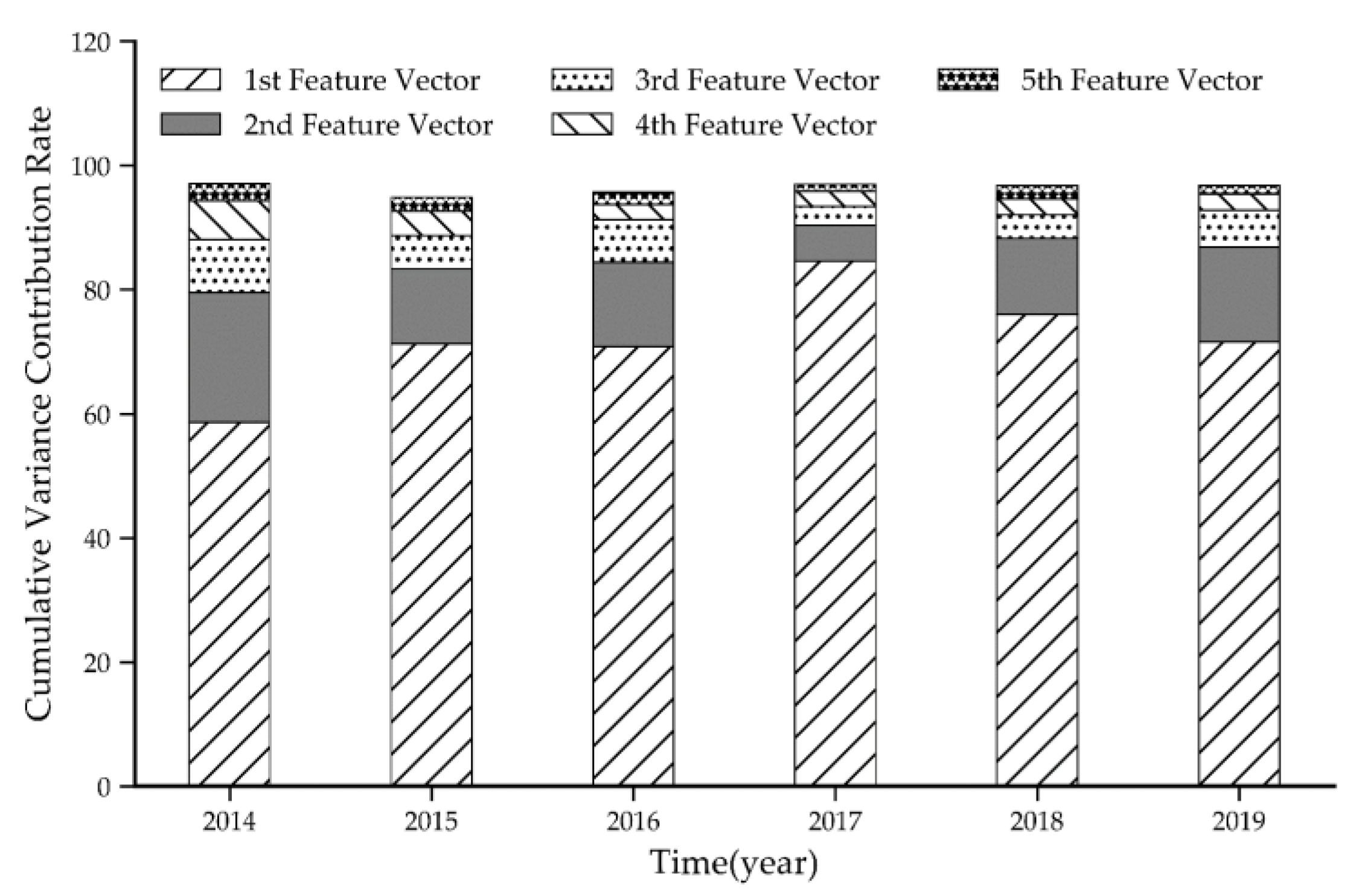
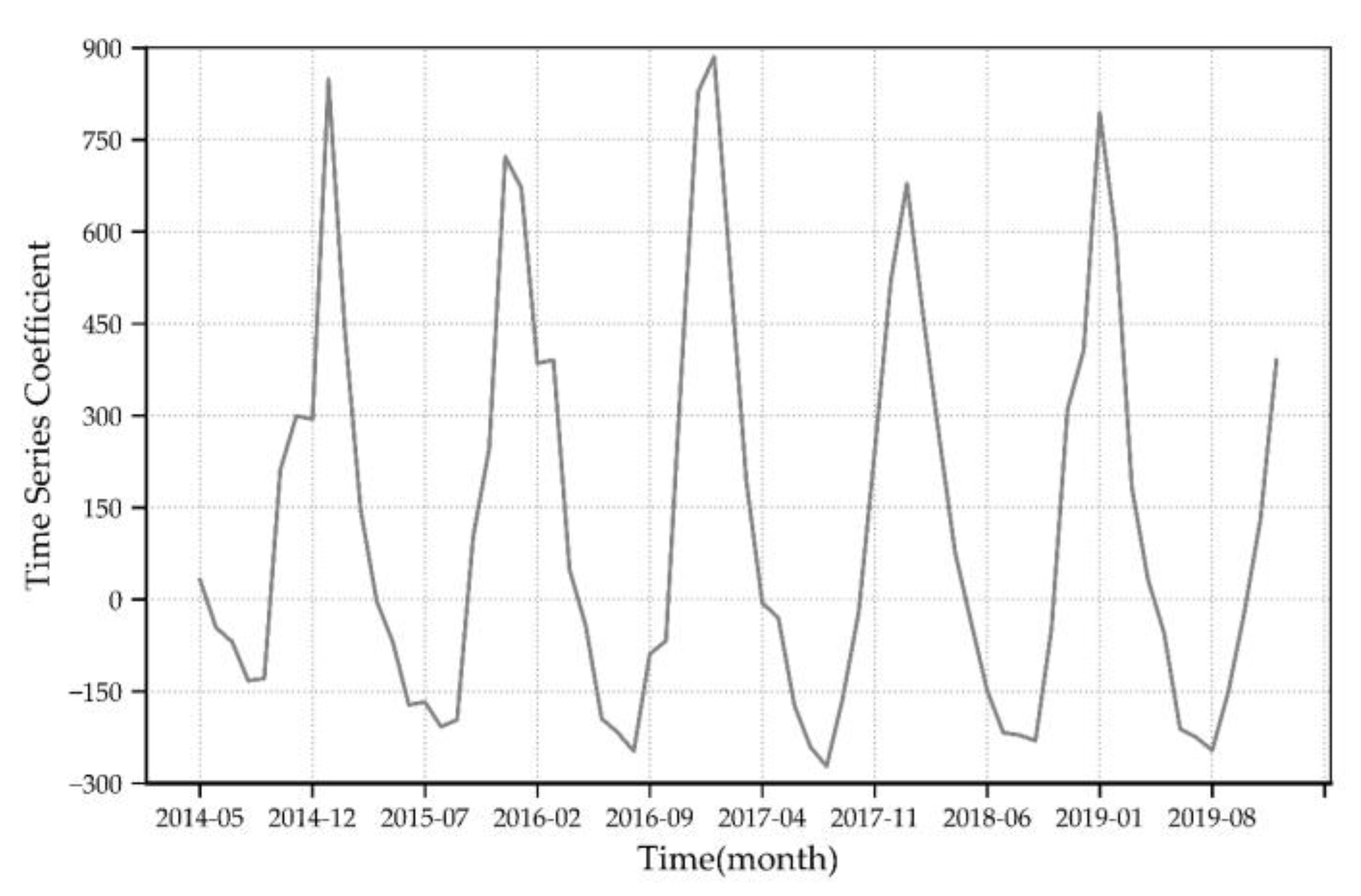

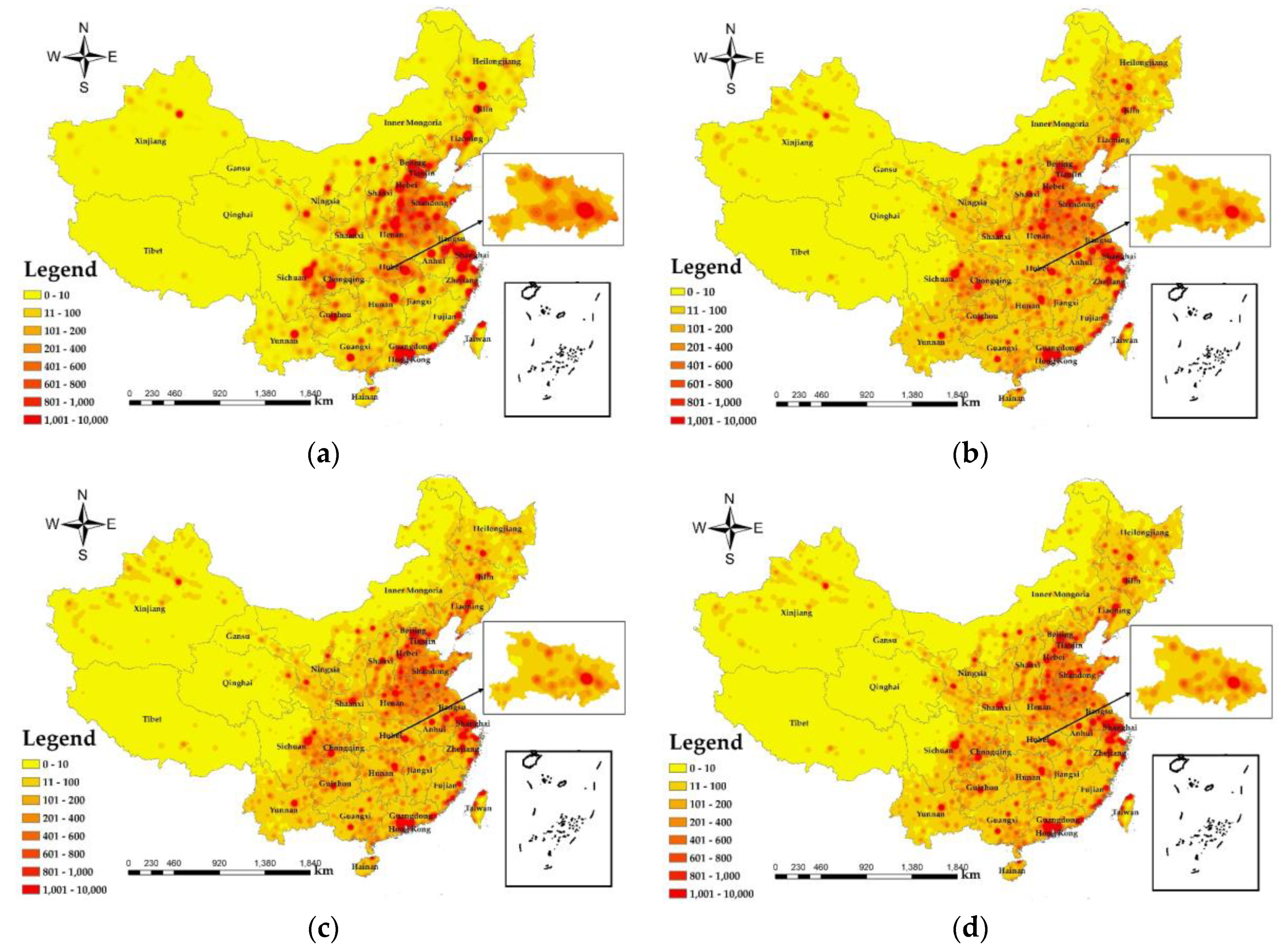
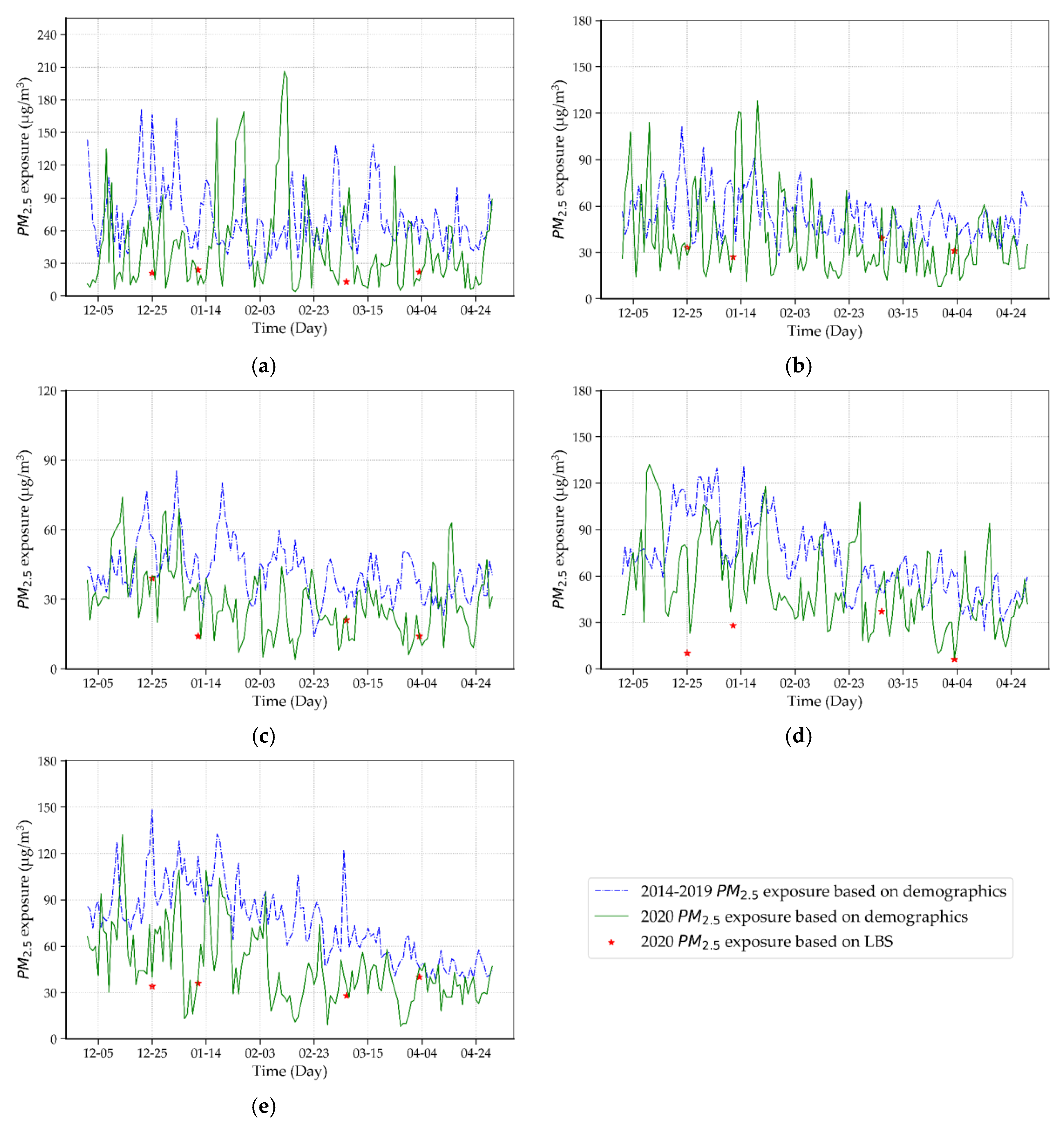
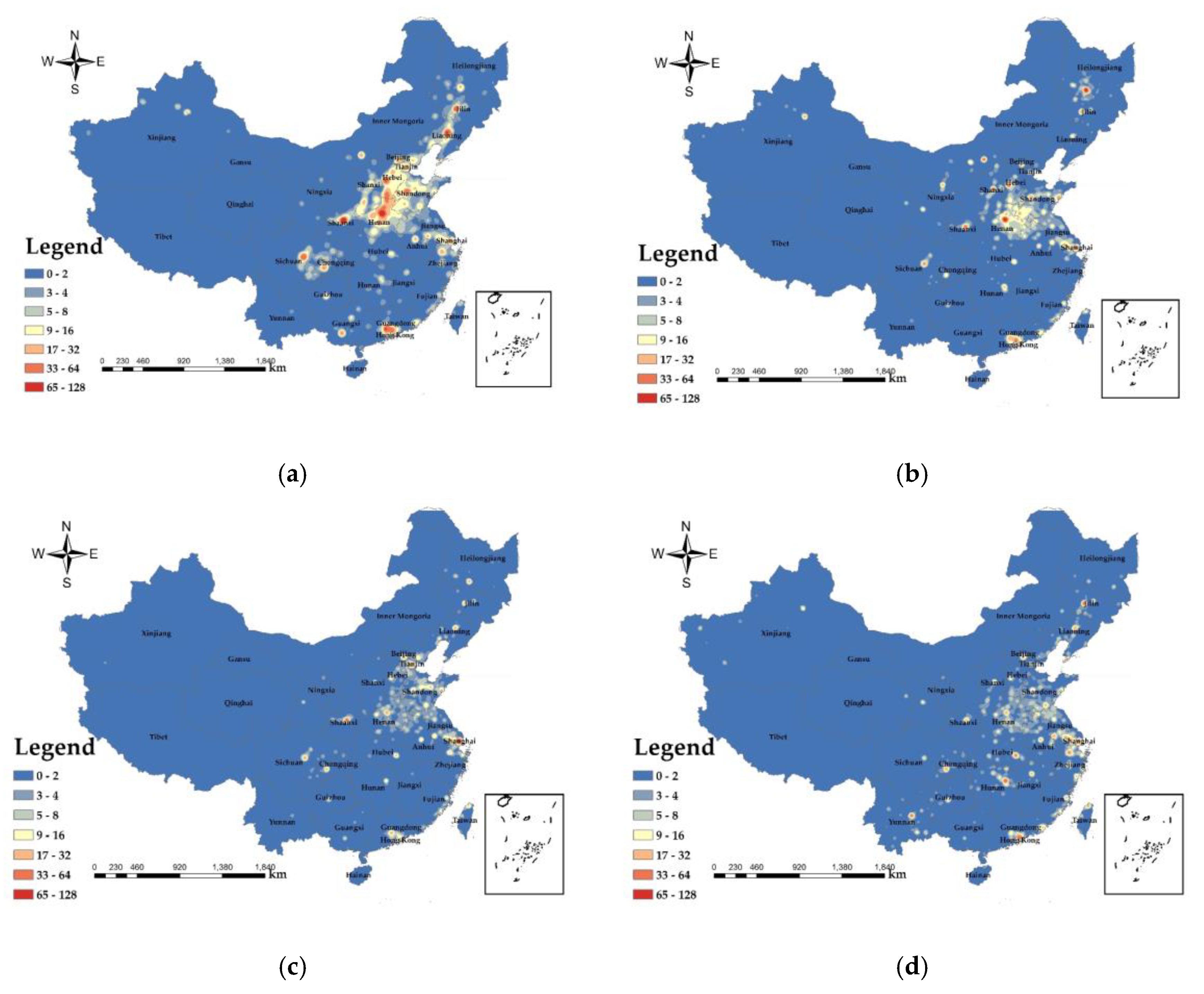
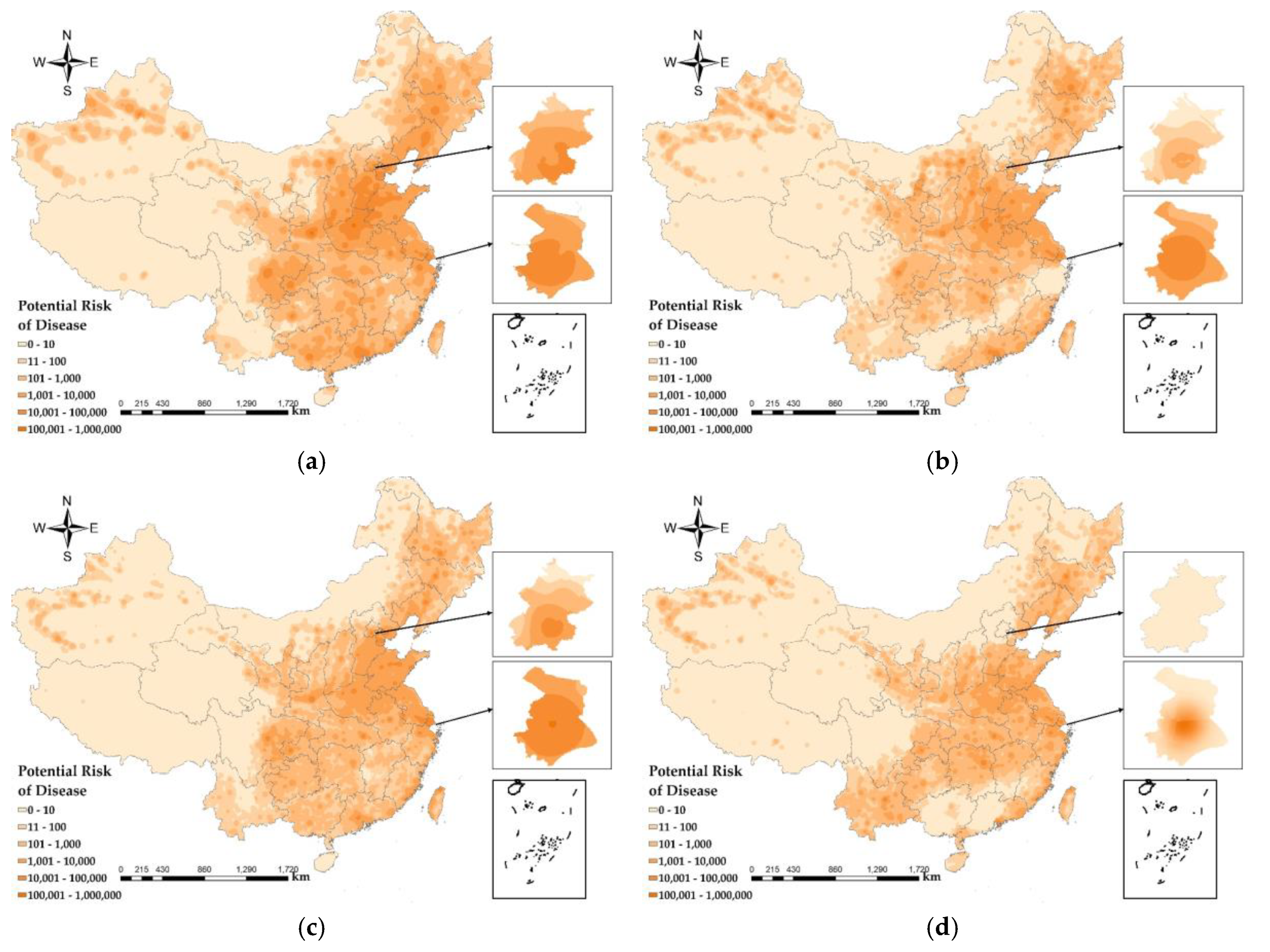
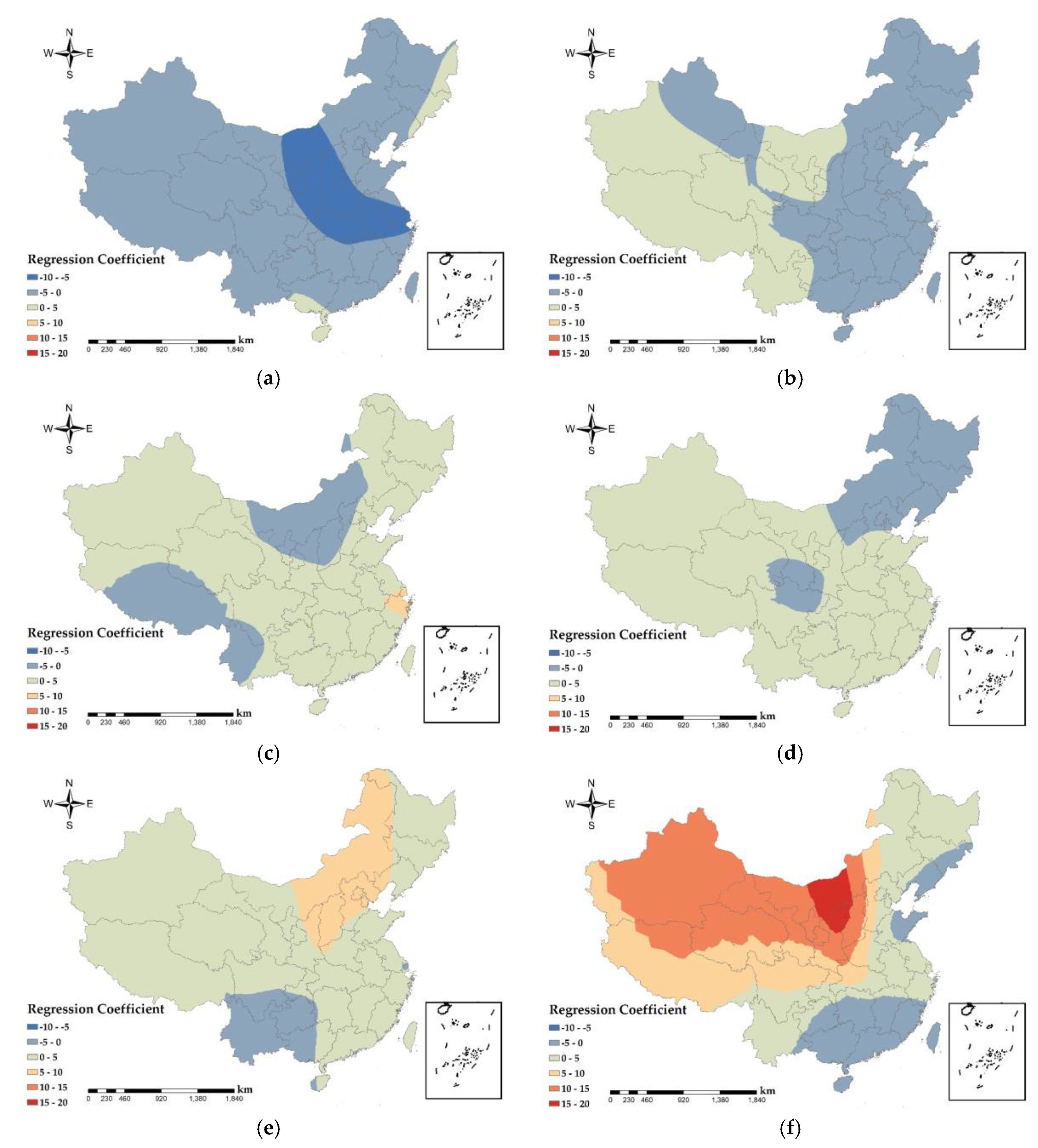
| Year | AICc | Residual Squares | ||
|---|---|---|---|---|
| 2014 | 2094.78 | 0.6759 | 0.6328 | 19078.16 |
| 2015 | 2095.02 | 0.6910 | 0.6501 | 19473.78 |
| 2016 | 2107.93 | 0.6303 | 0.5869 | 20026.23 |
| 2017 | 1977.24 | 0.6738 | 0.6315 | 13311.88 |
| Year | Urban GDP | Road Area | Green Space Area | Taxis | Buses | Factories |
|---|---|---|---|---|---|---|
| 2014 | −6.3 | 2.1 | −0.8 | 1.7 | 1.9 | 7.4 |
| 2015 | −4.8 | 1.7 | −0.5 | 1.1 | 2.3 | 3.3 |
| 2016 | −0.5 | 1.4 | −0.4 | 0.8 | 2.8 | 3.1 |
| 2017 | −1.7 | 1.1 | −0.4 | 0.4 | 1.9 | 0.8 |
Publisher’s Note: MDPI stays neutral with regard to jurisdictional claims in published maps and institutional affiliations. |
© 2020 by the authors. Licensee MDPI, Basel, Switzerland. This article is an open access article distributed under the terms and conditions of the Creative Commons Attribution (CC BY) license (http://creativecommons.org/licenses/by/4.0/).
Share and Cite
He, H.; Shen, Y.; Jiang, C.; Li, T.; Guo, M.; Yao, L. Spatiotemporal Big Data for PM2.5 Exposure and Health Risk Assessment during COVID-19. Int. J. Environ. Res. Public Health 2020, 17, 7664. https://doi.org/10.3390/ijerph17207664
He H, Shen Y, Jiang C, Li T, Guo M, Yao L. Spatiotemporal Big Data for PM2.5 Exposure and Health Risk Assessment during COVID-19. International Journal of Environmental Research and Public Health. 2020; 17(20):7664. https://doi.org/10.3390/ijerph17207664
Chicago/Turabian StyleHe, Hongbin, Yonglin Shen, Changmin Jiang, Tianqi Li, Mingqiang Guo, and Ling Yao. 2020. "Spatiotemporal Big Data for PM2.5 Exposure and Health Risk Assessment during COVID-19" International Journal of Environmental Research and Public Health 17, no. 20: 7664. https://doi.org/10.3390/ijerph17207664
APA StyleHe, H., Shen, Y., Jiang, C., Li, T., Guo, M., & Yao, L. (2020). Spatiotemporal Big Data for PM2.5 Exposure and Health Risk Assessment during COVID-19. International Journal of Environmental Research and Public Health, 17(20), 7664. https://doi.org/10.3390/ijerph17207664





